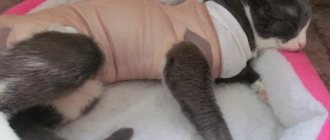04/25/2019 Drozd Nikolaevich Animals Owners of domestic cats often resort to castration. Most often this is simply necessary. An adult cat needs at least 8 cats per year to feel good. It is not always possible to provide him with such an opportunity in an ordinary city apartment. It is for this reason that a de-depleting procedure can help. But how cats tolerate castration is what worries caring owners. We will answer this and many other questions in the article.
What is it and how is it done?
Before considering how cats tolerate castration and other nuances of the intervention, we should dwell on the definition and types of manipulation.
During the procedure, the male’s testes are not simply removed, as is commonly thought, but the animal’s sexual function is also stopped, so different methods are used:
- Surgical method - performed through surgery. During it, the doctor opens the animal’s scrotum, removes the testes and ligates the canals.
- Medical sterilization. An implant is sewn under the animal’s skin, releasing drugs that suppress sexual instincts. The procedure is expensive, but is considered the safest.
- Chemical castration. In this case, substances are introduced into the testes that kill glandular tissue, which is subsequently replaced by connective tissue.
- Radiation sterility. In this case, the testes are placed under a source of gamma radiation. The method is quite simple, but the appropriate equipment is rarely found in clinics.
So, not every case requires a scalpel. The available choice of methods allows you to sterilize even old pets without risking their health and life. The veterinarian decides which castration is best for a cat, taking into account the age, health status of the animal and the capabilities available at the clinic.
In our country, they most often resort to the classical method of surgery. The reasons for this are the simplicity and cost-effectiveness of the technique. Let's dwell on it in more detail.
The procedure for sterilizing cats: methods and features
How cats are sterilized depends on the method chosen. There are three ways to perform the operation.
- Classic method. It is a skin incision in a previously prepared area along the white line of the abdomen slightly below the navel. The length of the incision is about 3 cm. This method allows you to remove both the uterus and ovaries. Its advantage is the possibility of direct access for a specialist to the cat’s organs. The disadvantage is the long length of the suture, which can provoke infection and bleeding.
- Using a side cut. Dissection of the abdominal cavity is carried out on the side of the midline of the abdomen, with the length of the wound not exceeding 1 cm. The method is not very convenient for performing manipulations and is used in situations where the classic option is not possible, or for tubal ligation. The advantage of the method is the rapid healing of a small incision, which reduces the risk of postoperative complications.
- Laparoscopic sterilization of cats. It makes it possible to remove both the uterus and ovaries through a small puncture in the abdominal wall. The entire process takes place using a special device, and the doctor’s actions are displayed on the monitor screen in real time. The method is characterized by minimal trauma to animal tissue, a reduced recovery period and a low likelihood of complications. However, it is rarely used, since it presupposes the availability of appropriate equipment in the clinic and the skills of a veterinarian, which ultimately adds up to the high cost of the procedure.
Each type of operation is performed under anesthesia, and the time for sterilization of cats is determined by the chosen method and can range from 15-20 minutes to one hour or more.
Early Intervention
Proponents of early sterilization recommend it be carried out at the age of two months. At this time, the genitals are not yet formed, and the regenerative capabilities of tissues are maximum. How do cats recover after castration performed at 2 months of age? After surgery, the pet recovers quickly, and the risk of developing postoperative complications is low.
However, there are also disadvantages. In case of early castration, the growth of the animal can be significantly slowed down, and the cat will remain miniature, which in adulthood will lead to problems in the skeletal, muscular and cardiac systems.
When is the best time to castrate a cat?
Master, I didn’t understand something...
At what age is it best to neuter a cat? Experts recommend performing the operation within 7-9 months. It is believed that up to 7 months the animal’s body is not yet sufficiently developed to tolerate the intervention well. After 9 months, most mustachioed pets have already entered puberty, which is manifested by appropriate behavior. There is a possibility that even after castration this stereotype may persist.
Castration of an adult cat requires greater responsibility and care on the part of the owner and veterinarian. The older the animal, the higher the risk of complications. An older pet may have a history of chronic diseases, intolerance to any medications, or decreased activity of the immune system, so adult cats are operated on only after a thorough examination or treated without castration using medication.
Surgery in adulthood
If late castration is performed - after the age of 2-3 years, in this case the behavior and habits of the animal are entrenched, coping with them can be difficult, and sometimes impossible. In addition, after late intervention, the risk of developing obesity and the appearance of urolithiasis in the animal is extremely high.
Thus, veterinarians believe that both early and late neutering are not very desirable. The ideal period for the operation is considered to be from 6 months to one year. At this time, sex hormones have not yet greatly influenced the development of the male, and the condition of the organs is ideal for intervention.
Veterinarians advise British cats to be neutered at the age of at least eight months. Persian - upon reaching one year. This is due to the later sexual development of these breeds. If they undergo surgery at an earlier age, the likelihood of negative consequences increases.
The nuances of castration of older cats
If the owner decides to undergo surgery on a pet that is more than three years old, a number of points should be taken into account:
- Castration is performed only under general anesthesia. Local anesthesia at this age is not effective and can cause painful shock.
- Adult cats recover from anesthesia quite difficult, and therefore the owner should be attentive to the condition of the pet.
- Preparation for the operation is required, which includes blood and urine testing. This allows you to determine whether the animal has chronic diseases.
- It is also worth conducting an allergy test to identify a reaction to anesthesia.
Suitable age for sterilization
Today, veterinarians around the world believe that it is best to sterilize an animal at the age of five to seven months.
Remember! The body of young kittens is more labile and adapts much faster to life without sources of sex hormones.
An exception to this rule are representatives of the Persian and British breeds: they are characterized by slower development, and therefore these cats should be castrated no earlier than seven to eight months, and some experts recommend waiting until a year.
It is in these cases (again, with the exception of the Persians and the British) that it is permissible to perform castration without anesthesia, using only local anesthesia. And the point here, by the way, is also in the biochemical characteristics of the pets’ body, which manifest themselves precisely at this age.
They consist in the fact that the liver and kidneys of kittens in this case are not yet fully developed. They may either not completely metabolize the agents used for anesthesia, or they may convert them into compounds that are deadly to the entire excretory system. Therefore, giving children general anesthesia is simply dangerous : no one can say for sure exactly how the medications will affect the pet’s body. Moreover, it is in “young people” that the development of severe side effects from general anesthesia is most often recorded, up to a medically induced coma (and animals rarely emerge from it).
Thus, all veterinarians agree that up to seven months, general anesthesia is not only unnecessary, but even dangerous. Exceptions are made only in some individual cases, and before performing the operation, the animal must be subjected to a full medical examination.
Possible complications
A classic cat castration operation lasts no more than 20 minutes. The recovery period is usually short; the pet recovers from anesthesia in an average day. Veterinarians recommend monitoring the animal for two days after surgery, monitoring how the cat behaves after castration, and not leaving it alone. This is due to the use of anesthesia, the side effects of which may appear during this time.
Some negative consequences of the operation are possible within 2-3 weeks after the intervention.
In what cases is it important to take your cat to the veterinarian:
- Bleeding. Occurs when the seams come apart. The blood flows in a thin stream and stains the fur. Treatment is surgical, so it is important to contact a veterinary clinic as soon as possible.
- Purulent inflammation. Possibly if the wound has become infected. Pus appears green, yellow, white, thick, with an unpleasant odor. Such a consequence is treated with antibiotics.
- Edema. It can develop if dirt or infection is brought into the wound. The scrotum swells, and the animal often experiences pain.
- Hernia. This is tissue loss that can occur, especially if the cat is older. The hernia is removed surgically; it is strictly forbidden to repair it yourself.
- Sepsis. Appears after a secondary complication after inflammation, hernia and other pathologies. At the same time, bacteria enter the blood and the temperature rises. Antibiotics are used for treatment.
- Pulmonary edema. The phenomenon is rare, but extremely dangerous. Due to heart failure, pressure in the pulmonary circulation increases, plasma enters the lungs, and oxygen supply decreases. The animal wheezes, coughs, and turns blue. If you don't get veterinary help quickly, the cat will suffocate.
Pros and cons of sterilization
Sterilization, like any surgical process, has advantages and disadvantages.
The arguments “For” include the following arguments:
- a cat is capable of bringing kittens not only annually, but even quarterly, up to 6 kittens at a time. Not all owners want to solve the problem of finding homes for all their children;
- the behavior of an animal during estrus is often inadequate: nighttime guttural cries, lack of appetite, a pervasive smell of urine in the house due to the cat’s desire to mark everything around with its smell;
- if there are babies in the house, a sterilized animal will not bring infection into the house;
- bearing and giving birth to offspring can cost the life of the owner’s beloved cat;
- if a cat is not allowed near the cat during heat, then a large amount of extra hormones appears, which has a detrimental effect on the pet’s psyche;
- increasing the lifespan of a cat.
It is also worth listening to the arguments “against” and drawing conclusions: this is an invasion of the natural course of events planned by nature. It turns out that a person first of all worries about his own peace of mind, and only then about the health of his pet.
The operation may not go as smoothly as we would like; it is difficult for the animal to recover from anesthesia and regain strength.
It is also important to understand that sterilization of a cat is an irreversible process, and the owner will never see kittens from his pet.
Reaction to anesthesia
How do cats cope with castration and anesthesia during it? If the animal is diagnosed with heart failure, this may negatively affect the condition after administration of the drug. Also at risk are certain breeds of cats - British, Scottish fold and others.
Signs of complications include severe shortness of breath and heart failure. To prevent this condition, the animal’s heart should be examined before surgery using ultrasound and ECG. If the risk of complications is high, it makes sense to refuse the operation or perform it under local anesthesia.
Why are cats sterilized?
The main reason for this is reproductive dysfunction, that is, the exclusion of unwanted offspring. With the help of this manipulation the number of animals is regulated. This is especially true these days, because kittens often join the ranks of homeless animals or are subject to killing. And the last thing is an inhumane attitude towards our smaller brothers.
Advertising:
Spaying and neutering pets helps resolve the issue of aggressive behavior during hormonal activity. After all, animals at this time become restless and can react violently to everything that happens. Male cats acquire a persistent, specific smell and mark everything around them, ignoring the litter box.
Important: the likelihood of diseases of the reproductive organs, including tumor processes in girls, increases, therefore sterilization is a method for preventing such.
What is the care after surgery? What are the owner's actions?
Owners often ask the veterinarian how to care for a cat after castration? If local anesthesia was used, this process is greatly simplified. The main thing in this case is to eliminate the stressful state. To do this, the cat is given more attention and affection, and postoperative care consists of treating the wound. It is cleaned daily with a damp cotton swab, treated with an antiseptic and a bandage is applied.
To prevent the cat from tearing the seams, an Elizabethan collar and blanket are put on it for 4-6 days. If any of the negative consequences described earlier occur, you should go to the veterinarian.
How to care for a cat after sterilization
Few owners have a complete idea of what to do after sterilizing a cat. Meanwhile, it is the postoperative period that determines the further state of the pet’s health.
If it is not possible to leave the cat in the clinic for the first few days, and she is “discharged” home immediately after the operation, you need to learn in detail all the nuances of care from a veterinarian. Depending on the pet’s condition before and after the intervention, she may be prescribed antibacterial drugs, anti-inflammatory drugs or painkillers. In addition, the specialist will tell you when (and whether) you need to come to remove the stitches, how often to do dressings, what products are best to use in this case, and other information. It would be good if the veterinarian can give his phone number so that in case of a sharp deterioration in the condition, he can be contacted without delay.
Features of transporting an animal from the clinic
You need to take your cat home not in your arms, but by placing it in a special carrier that has a flat and even bottom. Any shaking or displacement of the torso can cause the seams to separate. It is advisable to cover the animal with a light blanket or warm cloth, since due to the operation and anesthesia, the pet’s body temperature becomes lower than normal.
Where is the best place to place a cat in an apartment?
While the cat is recovering from sterilization, it is best for her to be on the floor. The owner needs to arrange the bed in advance: choose a spacious place where no one can disturb the animal, lay down a blanket, and put waterproof diapers on top. To ensure free flow of saliva, the pet should be placed on its right side.
It is imperative to ensure that the place reserved for the cat is not in a draft or near a heating device. However, you will still need to cover it; to do this, just take a light but dense fabric.
What to wear on a cat after sterilization
Cat in a blanket after sterilization
After sterilization, the cat's stomach should be isolated from the external environment to avoid infection of the wound. To do this, use a blanket - special clothing with slots for paws, fastened with Velcro or tape on the back of the animal. The device should be worn for about 10-14 days, depending on the complexity of the operation, the condition of the seam and other nuances.
Cat blankets should be washed, ironed, and then put on again. Such clothing is removed only to treat the surgical wound. To prevent your pet from taking it off, there should be no threads or loose ends of ties sticking out on the blanket. The product is selected only according to individual sizes, since the animal will easily remove a wide blanket, while a narrow blanket will interfere with blood flow.
Some owners sew such bandages themselves. Sometimes tights or socks are used as a means of improvisation, having previously cut holes. Whether the cat will wear such a blanket is unknown. Judging by the stories of owners on the Internet, many animals stage concerts or behave aggressively, even without fully recovering from anesthesia. As a result, the blanket is replaced with a collar, and the bandage on the wound is fixed with a plaster.
Coming out of anesthesia
The cat's behavior after surgery becomes inadequate and unpredictable due to anesthesia. During the first 1-2 days, the animal should not be left alone for a long time. Coming out of a narcotic state is accompanied by complete disorientation in space, staggering, wobbly limbs, screaming, meowing, aggression and other manifestations.
The duration of recovery of a cat from anesthesia can range from 5-6 hours to a day or more. But the pet usually begins to come to its senses 2-4 hours after the operation. There is no need to give her anything to drink, much less eat, at this time. It is allowed to moisten the oral cavity with water from a spoon or syringe.
How to feed a cat after sterilization
It is prohibited to feed the cat within 24 hours after sterilization. This is associated with the risk of a gag reflex (due to anesthesia) and decreased intestinal activity. Any contraction of the abdominal muscles or intestinal wall can lead to the opening of the wound or provoke intra-abdominal bleeding. Liquid food in the form of broth, meat ground and mixed with broth, porridge with water can be introduced into the animal’s diet approximately on the second day. You will need to follow a liquid diet until the stitch is removed.
If your cat refuses food and water
The first day after sterilization, the pet may not have an appetite. The alarm should be sounded if the cat does not eat or drink for more than 2 days, and all attempts to give it liquid food or water using a syringe end in failure. To recover, she definitely needs to take at least broth. To prevent dehydration and exhaustion of the pet, the owner should contact the clinic - an alternative may be intravenous nutrition.
Toilet problems
It happens that a cat does not go to the toilet after sterilization. If this happens within 1-2 days after surgery, then there is no need to worry. Due to preoperative fasting and dehydration, she simply has nothing to empty her bowels with. Other reasons for this phenomenon include:
- stress from surgery;
- the effect of anesthesia or drugs;
- the blanket gets in the way;
- the seam hurts.
Lack of bowel movements with normal appetite may indicate constipation. In this case, laxatives and a liquid diet will help. If your cat continues to have problems with the toilet more than 3 days after sterilization, you should immediately consult a veterinarian.
After general anesthesia
How to care for a cat after castration in this case? In the first hours after the intervention, the pet experiences severe weakness, nausea, and dizziness. This is how the animal recovers from anesthesia. What should the owner do after castrating a cat? Sometimes he is offered to leave the animal in the clinic for a day after the operation. However, an animal can only calm down and feel the care of its owner at home.
After general anesthesia, the cat has:
- Dry eyes. During the operation, the cats' eyes do not close; the veterinarian does this manually so that the conjunctiva is moistened with tears. After the procedure, if the pet has not yet recovered from anesthesia, the owner will need to do this. How long does it take for a cat to recover from castration? This may take several hours. If the animal lies with its eyes open for a long time, you can drip saline solution.
- Reduced body temperature. If cats normally have a temperature of 37.5-39.0 degrees, then after surgery it can be 36.5-37.0. To prevent the animal from freezing, it is worth covering it with a warm blanket. To normalize blood circulation, the cat's paws and ears are rubbed.
- Unsteady gait. This is due to the fact that the muscles relaxed during the application of anesthesia. So the pet can walk on the first day after the procedure. It is worth monitoring how the cat behaves after castration, so that the animal does not climb somewhere where it cannot get out.
- Painful sensations. Even though the animal is silent, this does not mean that it is not in pain. After the operation, the cat is in a depressed state and needs painkillers.
After surgery, you need to check the animal's groin area daily and check for bleeding.
To make the stitches heal faster, the wound is treated with hydrogen peroxide and brilliant green. You can also lubricate with Levomekol.
The doctor may prescribe a 5-day course of antibiotics to avoid possible complications.
How does anesthesia work on a cat?
Castration of cats (as well as males of other species) is considered the simplest and safest manipulation, unlike sterilization of cats - an abdominal operation that does not always end well.
There is no need to worry about how anesthesia will affect your animal or what complications there may be. Strong drugs are not used during castration. As a rule, in order for the procedure to be easy and painless, a light drug is sufficient to temporarily anesthetize the animal and put it to sleep without causing the slightest harm to its health.
The dosage of the drug is calculated based on the body weight and age of the four-legged patient. Veterinarians drew attention to a curious fact: animals with red fur require a larger dose of the drug than representatives of the cat breed of any other color, although the body weight of both may be the same.
It will take about 10-30 minutes for the cat to fall asleep after the administration of anesthesia. This does not depend on the quality of the drug used and, especially, not on the qualifications of the doctor. These are the individual characteristics of the body of each of our pets.
Some cats may feel nauseous after the injection, and sometimes vomiting occurs. This is a natural reaction of the body, often appearing in response to the administration of this type of drug. There is no need to worry about this, it’s just better not to feed the cat a few hours before the operation.
The cat's toilet after the procedure
During the postoperative period, light-colored litter should be poured into the cat's litter box in order to notice possible bleeding in time. It is better to purchase a soft adsorbent to avoid irritation.
After castration, some owners put a small diaper on their pet, in which they have previously made a hole for the tail.
It may be that the cat does not have a toilet for a long time - neither big nor small, or the urine comes out little by little. This is quite normal.
Vaseline oil will help cope with constipation. It is poured into the animal’s mouth in a small amount; if after 20 minutes no negative reaction is observed, another 15-20 grams are given. After 3 hours, the animal's intestines should gently empty.
Sterilizing a cat at home
The procedure for sterilizing a pet at home is no different from the same operation, but in a clinic. Everything is going according to plan:
- Examination of the pet's health, including urine, blood, ECG, and ultrasound tests.
- Preparation for the chosen method of operation: stop feeding your pet 8-12 hours before the due date, and drinking 3 hours before the start of action.
- Introducing an animal into anesthesia.
- Carrying out surgery, suturing.
- The postoperative period consists of caring for the cat immediately after it comes out of anesthesia.
It is important to ensure that your pet does not lick the seam even through the blanket.
How and what to feed?
In the first hours after castration, the cat does not eat anything because his appetite is reduced. You should not force feed an animal. However, water must be available to him in sufficient quantities.
Castrated males have an increased risk of developing urolithiasis, so veterinarians do not recommend feeding such animals fish. It contains increased levels of phosphorus, calcium and magnesium, which can lead to the formation of stones in the urinary system.
Experts advise purchasing special dry food for castrated and sterilized cats and feeding the animal with it. The composition of this diet acidifies the urine, which prevents the occurrence of urolithiasis. But at the same time, the cat must drink more liquid in order to go to the toilet normally. The feed to water ratio should be 1:3. If your pet rarely goes to the toilet, you should contact your veterinarian for a diuretic prescription.
In general, a neutered cat asks for food more often. This does not mean that he is hungry. It’s just that his interests are shifting away from cats, and the resulting void needs to be filled with something. The owner should not follow the lead of the animal, otherwise obesity is very close.
Nutrition after castration
In the first day and even days after castration, many cats completely refuse to eat, but drink a lot. Attempts to feed the cat by force only cause resistance and even greater aversion to any type of food. Don't worry, the body itself “knows” when it needs nutrition. As a last resort, ask your veterinarian if this is normal.
In the future, when your cat has fully recovered from the operation, it will be necessary to switch him to a specialized diet intended for castrated animals. It is perfectly balanced and lower in calories, which means that your pet will not suffer from obesity - practically the only negative point among the many advantages of castration.
It will be a little more difficult to provide the cat with proper nutrition with natural products. You will have to reduce your pet's usual portion and also reduce its calorie content. The most suitable food for a neutered cat is dietary chicken or rabbit meat, and occasionally low-fat fish. You can add a spoon or two of rice or buckwheat porridge to meat or fish dishes if your pet is accustomed to the side dish, but in this case you need to especially carefully monitor your weight and, if it increases, immediately reduce the amount of carbohydrates. In addition, at least twice a week the cat should be treated to kefir or yogurt, and to improve peristalsis and better cleanse the intestines, sow grass for it in a flowerpot.
To summarize
So we looked at how cats tolerate castration. A timely operation will get rid of such an unpleasant phenomenon as the smell in the house that is formed due to the fact that the animal is marking the territory.
The procedure performed will also protect the cat from health problems that cause prolonged sexual abstinence. Veterinarians do not recommend castrating an animal in adulthood, since aggressiveness and many formed habits will no longer leave the cat.
Source: fb.ru
How long does the operation take?
As a rule, castration of a cat takes place very quickly: literally in 10-20 minutes. It takes much more time to prepare for it. During the operation, the testes responsible for the production of sex hormones are removed. The veterinarian makes thin incisions through which he removes them. If the pet owner is present for the operation, the doctor may show the extracted testes to prove that the operation was successful.
Many cat owners feel remorse because they have deprived their pet of its privacy, made it inferior, and practically an undercat. It would be a huge mistake to think so. Castration deprives the cat of interest in the tailed representatives of the fair sex and the possibility of reproduction - but that’s all!
Think about how many uncastrated cats die under the wheels of cars and in the teeth of stray dogs, how many fall from balconies and loggias when, obeying the call of ancient instinct, they go in search of a partner! Painful death or serious injury – would you really want such a fate for your pet? Of course not. So put all your regrets aside and give your pet maximum attention while he recovers from surgery. By doing this, you will further strengthen his affection for you, and you yourself will be able to atone for your completely groundless guilt before him for the damage caused - and, by the way, greatly exaggerated! – suffering.











